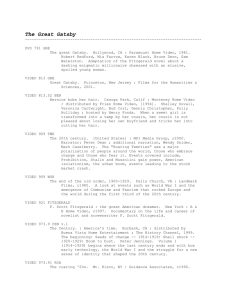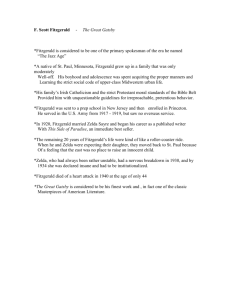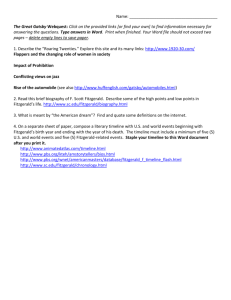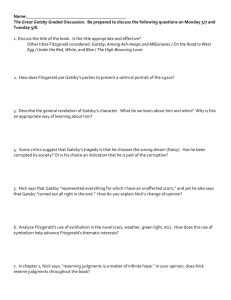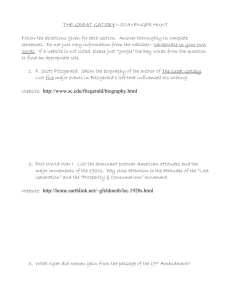hand out - MSAD #37
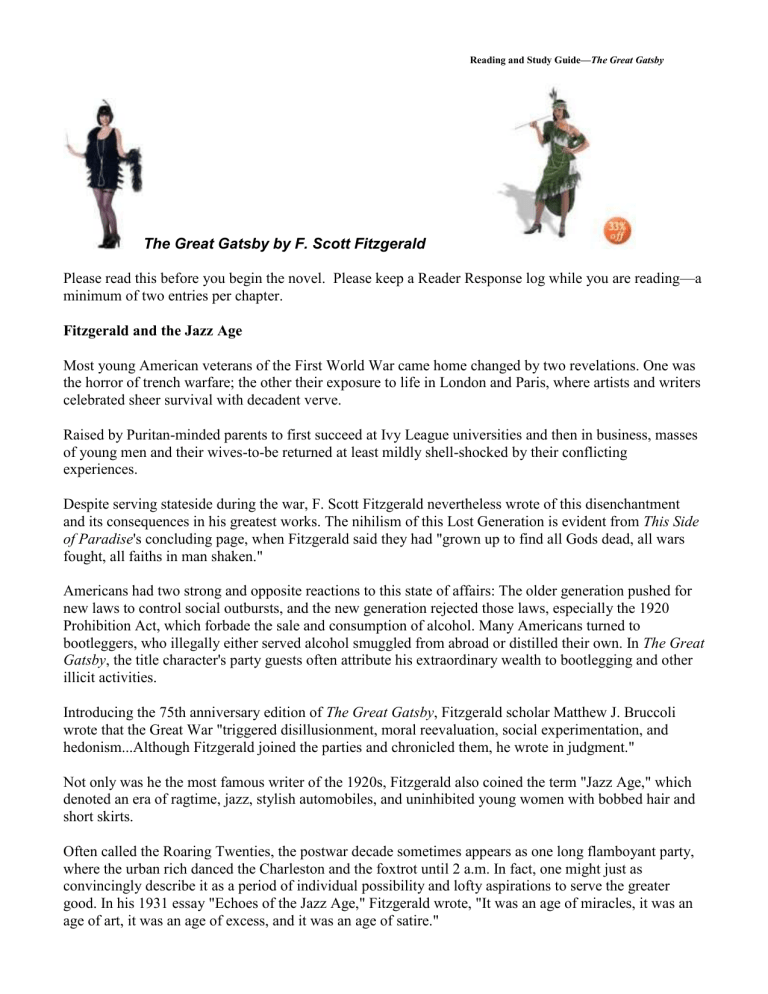
Reading and Study Guide—The Great Gatsby
The Great Gatsby by F. Scott Fitzgerald
Please read this before you begin the novel. Please keep a Reader Response log while you are reading—a minimum of two entries per chapter.
Fitzgerald and the Jazz Age
Most young American veterans of the First World War came home changed by two revelations. One was the horror of trench warfare; the other their exposure to life in London and Paris, where artists and writers celebrated sheer survival with decadent verve.
Raised by Puritan-minded parents to first succeed at Ivy League universities and then in business, masses of young men and their wives-to-be returned at least mildly shell-shocked by their conflicting experiences.
Despite serving stateside during the war, F. Scott Fitzgerald nevertheless wrote of this disenchantment and its consequences in his greatest works. The nihilism of this Lost Generation is evident from This Side of Paradise 's concluding page, when Fitzgerald said they had "grown up to find all Gods dead, all wars fought, all faiths in man shaken."
Americans had two strong and opposite reactions to this state of affairs: The older generation pushed for new laws to control social outbursts, and the new generation rejected those laws, especially the 1920
Prohibition Act, which forbade the sale and consumption of alcohol. Many Americans turned to bootleggers, who illegally either served alcohol smuggled from abroad or distilled their own. In The Great
Gatsby , the title character's party guests often attribute his extraordinary wealth to bootlegging and other illicit activities.
Introducing the 75th anniversary edition of The Great Gatsby , Fitzgerald scholar Matthew J. Bruccoli wrote that the Great War "triggered disillusionment, moral reevaluation, social experimentation, and hedonism...Although Fitzgerald joined the parties and chronicled them, he wrote in judgment."
Not only was he the most famous writer of the 1920s, Fitzgerald also coined the term "Jazz Age," which denoted an era of ragtime, jazz, stylish automobiles, and uninhibited young women with bobbed hair and short skirts.
Often called the Roaring Twenties, the postwar decade sometimes appears as one long flamboyant party, where the urban rich danced the Charleston and the foxtrot until 2 a.m. In fact, one might just as convincingly describe it as a period of individual possibility and lofty aspirations to serve the greater good. In his 1931 essay "Echoes of the Jazz Age," Fitzgerald wrote, "It was an age of miracles, it was an age of art, it was an age of excess, and it was an age of satire."
The Roaring Twenties
1920
The 18th Amendment, establishing Prohibition, becomes law.
The 19th Amendment passes, giving 26 million women the right to vote.
Warren G. Harding is elected President.
1921
Charlie Chaplin stars in The Kid .
Coco Chanel introduces Chanel No. 5.
Rorschach inkblot tests first used.
"Shoeless" Joe Jackson and others banned from baseball in wake of the "Black Sox" scandal.
1922
James Joyce's Ulysses published.
T.S. Eliot's The Waste Land published.
First issue of Reader's Digest published.
Louis Armstrong leaves New Orleans for Chicago to play with King Oliver.
Dance marathon craze begins.
1923
First transcontinental nonstop flight takes off from New York and lands in San Diego.
Jelly Roll Morton makes his first Paramount recordings in Chicago.
President Harding dies; Calvin Coolidge takes oath of office.
1924
George Gershwin premieres Rhapsody in Blue .
J. Edgar Hoover appointed Director of the Bureau of Investigation, later named the FBI.
The 10 millionth Model T rolls off the Ford assembly line.
Colleen Moore plays the title role in the film The Perfect Flapper .
1925
Charles Scribner's Sons publishes The Great Gatsby .
First issue of the New Yorker goes to press.
After John Scopes is charged with teaching from Darwin's Origin of Species ,
Clarence Darrow takes his case.
1926
The value of bootlegging in the U.S. estimated at $3.6 billion.
Benny Goodman records his first solo, "He's the Last Word," with the Ben Pollack Band.
Henry Ford institutes the 5-day workweek and 8-hour workday.
1927
The Jazz Singer opens as the first talking motion picture.
Charles Lindbergh lands his Spirit of St. Louis in Paris after the first trans-Atlantic flight.
Ford introduces the Model A.
Duke Ellington opens a four-year residency at the Cotton Club in New York City.
1928
Walt Disney makes his first Mickey Mouse silent short, Plane Crazy , and succeeds with his second one,
Steamboat Willie , which was synchronized with sound.
Amelia Earhart becomes the first woman to make a trans-Atlantic flight.
Herbert Hoover is elected President.
1929
March 26: The New York Stock Exchange hits a record high, with 8.2 million shares traded.
The Gerber Co. invents canned baby food.
Ernest Hemingway's A Farewell to Arms is published.
October 29: On Black Tuesday, the stock market crashes.
Thematic Connections—What to watch for, questions to ask--
1.
Watch for connections between the 1920’s and today.
2.
How do Americans measure success both in the 1920’s and today?
3.
The superficiality of modern life--
4.
Materialism—
5.
The impact of WWI
6.
And, once again…The American Dream--
Credits
Writer: Sarah Bainter Cunningham for the National Endowment for the Arts.
Excerpts from the novel reprinted with permission of Scribner, an imprint of Simon & Schuster Adult
Publishing Group, from The Great Gatsby by F. Scott Fitzgerald. Copyright 1925 by Charles Scribner's
Sons. Copyright renewed 1953 by Frances Scott Fitzgerald Lanahan.
Bruccoli, Matthew J., Preface. The Great Gatsby . By F. Scott Fitzgerald. New York: Simon and Schuster,
1995. vii-xvi.
Fitzgerald, F. Scott. The Crack-Up . Ed. Edmund Wilson. New York: New Directions, 1945.
—.
The Letters of F. Scott Fitzgerald . Reprinted with permission of Scribner, an imprint of Simon &
Schuster Adult Publishing Group from The Letters of F. Scott Fitzgerald edited by Andrew Turnbull.
Copyright 1963 by Frances Scott Fitzgerald Lanahan. Copyright renewed 1991.
—. This Side of Paradise . 1920. New York: Scribner, 1998. http://www.neabigread.org/books/greatgatsby/ggatsby11.php
The Great Gatsby
Discussion Questions
1.
The novel's action occurs in 1922 between June and September. How does Nick's nonchronological narration shape your response to the events surrounding the mystery of Jay Gatsby?
2.
Nick believes he is an honest, non-judgemental narrator. Do you agree?
3.
Gatsby believes that the past can be repeated. Is he right?
4.
Why does Daisy sob into the "thick folds" of Gatsby's beautiful shirts?
5.
What do the faded eyes of Doctor T.J. Eckleburg symbolize? Is there a connection between this billboard and the green light at the end of Daisy's dock?
6.
Perhaps the novel's climax occurs when Gatsby confronts Tom in New York. Did Daisy's ultimate choice surprise you? Is it consistent with her character?
7.
Do you agree with Nick's final assertion that Gatsby is "worth the whole damn bunch put together"? Why or why not?
8.
How does Fitzgerald foreshadow the tragedies at the end?
9.
Does the novel critique or uphold the values of the Jazz Age and the fears of the Lost Generation?
10.
Fitzgerald wrote, "You don't write because you want to say something, you write because you have something to say." What did he have to say in Gatsby?
11.
Fitzgerald scholar Matthew J. Bruccoli claims: " The Great Gatsby does not proclaim the nobility of the human spirit; it is not politically correct; it does not reveal how to solve the problems of life; it delivers no fashionable or comforting messages. It is just a masterpiece." Do you agree?
If you're intrigued by the 1920s, you might also enjoy reading:
Ernest Hemingway's The Sun Also Rises (1926)
If you're intrigued by novels about lives of privilege, you might also enjoy reading:
John O'Hara's Appointment in Samarra (1934)
If you're intrigued by the Fitzgeralds, you might also enjoy Zelda's only novel:
Zelda Fitzgerald's Save Me the Waltz (1932)

